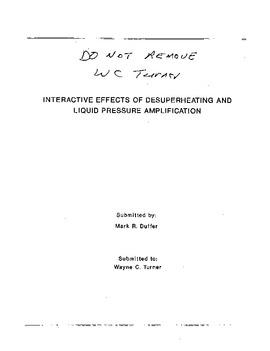| dc.contributor.advisor | Turner, Wayne C. | |
| dc.contributor.author | Duffer, Mark R. | |
| dc.date.accessioned | 2015-09-29T19:58:35Z | |
| dc.date.available | 2015-09-29T19:58:35Z | |
| dc.date.issued | 1986 | |
| dc.identifier.uri | https://hdl.handle.net/11244/19238 | |
| dc.description.abstract | This paper explores the interactive effects of installing desuperheating and a liquid pressure amplification together in a refrigeration or air conditioning system. Only "Freon" systems using reciprocating compressors are addressed in this paper since these are the only systems to which liquid pressure amplification can be applied. | |
| dc.description.abstract | The major conclusion derived from this study is that there are many applications where these two technologies can be installed successfully and economically together on the same machine. In general, installations where the cooling load is large throughout the year are the most desirable. Examples of this would be a thermally heavy commercial building or a process cooling load. In addition, the savings and simple payback tend to improve as the machine tonnage increases. The refrigerant used also has an impact on the economics of the installation. Of the three refrigerants considered (R-12, R-22, and R-502), the savings and payback were best for R-502. | |
| dc.format | application/pdf | |
| dc.language | en_US | |
| dc.rights | Copyright is held by the author who has granted the Oklahoma State University Library the non-exclusive right to share this material in its institutional repository. Contact Digital Library Services at lib-dls@okstate.edu or 405-744-9161 for the permission policy on the use, reproduction or distribution of this material. | |
| dc.title | Interactive effects of desuperheating and liquid pressure amplification | |
| osu.filename | Thesis-1986R-D856i.pdf | |
| osu.accesstype | Open Access | |
| dc.type.genre | Master's Report | |
| dc.type.material | Text | |
| thesis.degree.grantor | Oklahoma State University | |
